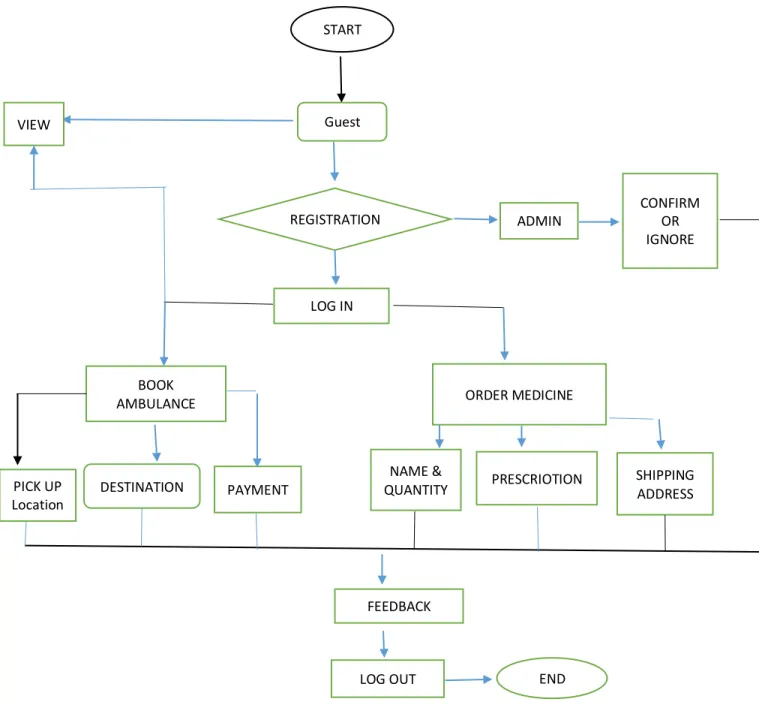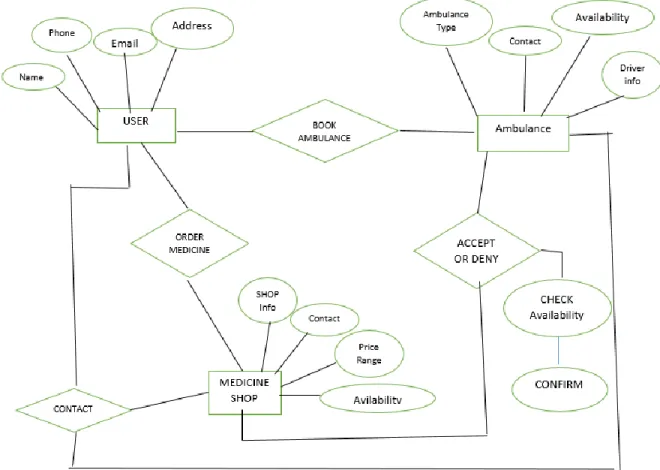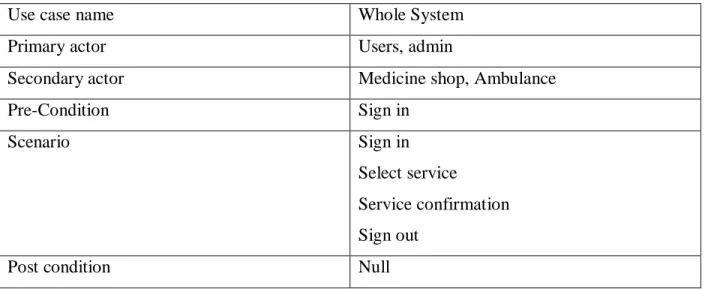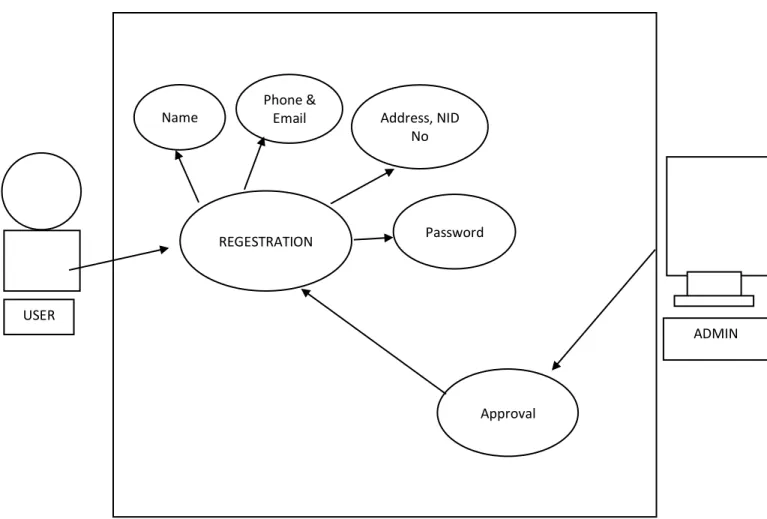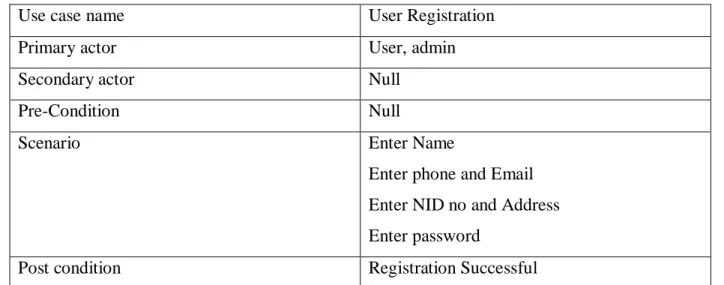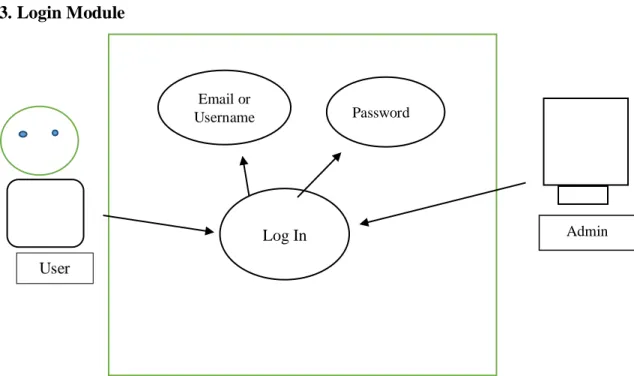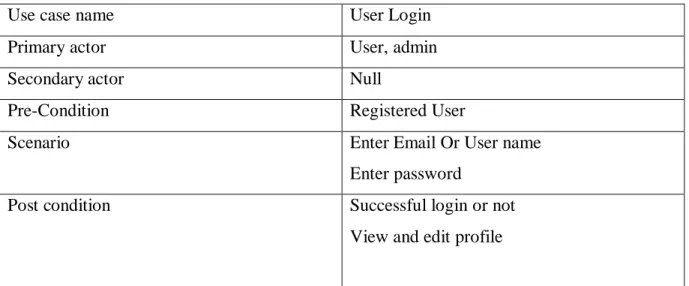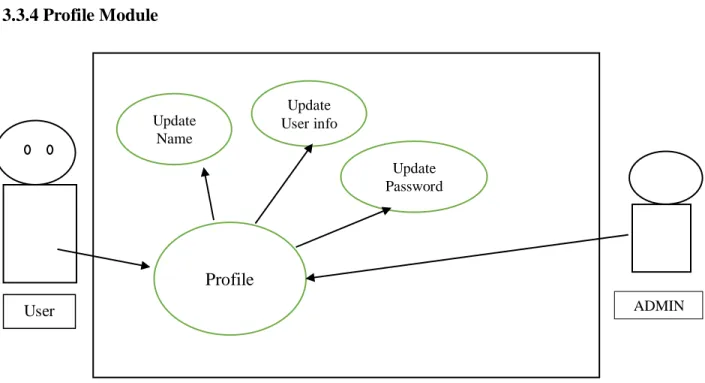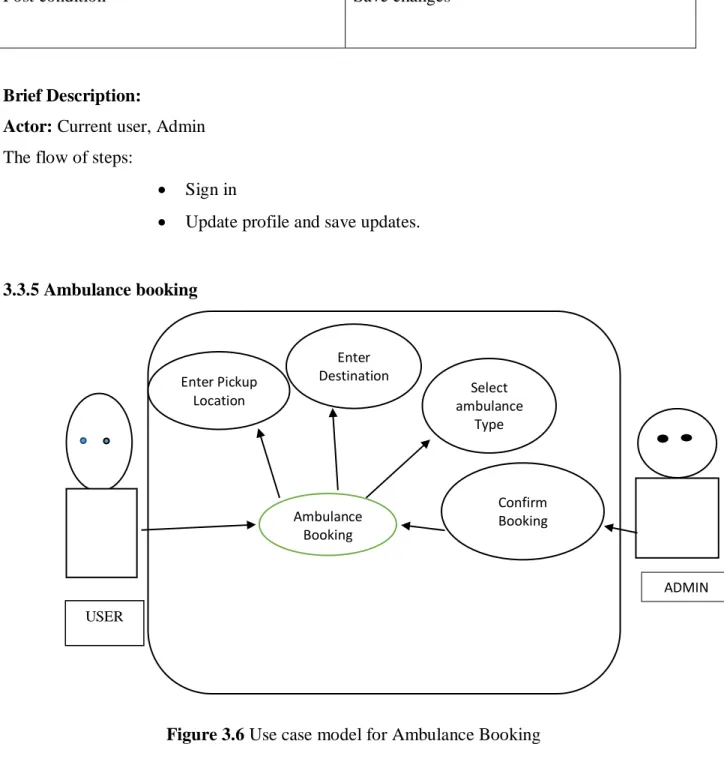© Daffodil International University
DEVELOPMENT OF WEB BASED APPLICATION OFONLINEASSISTANCE FOR EMERGENCY SITUATION
BY
KAMOLAXMO BARMAN ID: 152-15-6007
AND
HIRAK JYOTI PAUL ID: 152-15-5521
This Report Presented in Partial Fulfillment of the Requirements for the Degree of Bachelor of Science in Computer Science and Engineering.
Supervised By
Anup Majumder Lecturer Department of CSE
Daffodil International University
Co-Supervised By
Md. Jueal Mia Lecturer Department of CSE
Daffodil International University
DAFFODIL INTERNATIONAL UNIVERSITY DHAKA, BANGLADESH
MAY 2019
© Daffodil International University i
© Daffodil International University
© Daffodil International University
ACKNOWLEDGEMENT
First we express our heartiest thanks and gratefulness to almighty God for His divine blessing makes us possible to complete the final year project successfully.
We really grateful and wish our profound our indebtedness to Anup Majumder, Lecturer, Department of CSE, Daffodil International University, Dhaka. Deep knowledge & keen interest of our supervisor in the field of “WebApplication” to carry out this project. His endless patience, scholarly guidance, continual encouragement, constant and energetic supervision, constructive criticism, valuable advice, reading many inferior draft and correcting them at all stage have made it possible to complete this project.
We would like to express our heartiest gratitude to Anup Majumder, Lecturer, Department of CSE, Md. Jueal Mia, Lecturer, Department of CSE, and Professor Dr. Syed Akhter Hossain, Head, Department of CSE, for his kind help to finish our project and also to other faculty member and the staff of CSE department of Daffodil International University.
We would like to thank our entire course mate in Daffodil International University, who took part in this discuss while completing the course work.
Finally, we must acknowledge with due respect the constant support and patients of our parents and beloved family members.
iii
© Daffodil International University
ABSTRACT
This project is on “Development of Web Based Application ofOnline Assistance for Emergency Situation”. This is a kind of web application, which helps to communicate with users within a short time. The main aim of this application or software is to provide Ambulance service virtually within a short time. And it’s another objective is people can order medicine here and get delivered at their doorstep. Users here can easily get several services without installing any software. To develop this project, the essential part is making a web application using HTML, CSS, JAVA-SCRIPT, JQUERY, AJAX, PHP, MySQL. After implementation of all functions, the system is tested in different stages and it works successfully as a prototype.
iv
© Daffodil International University
TABLE OF CONTENTS
CONTENTS PAGE
Board of examiners i
Declaration ii
Acknowledgements iii
Abstract iv
Table of contents v
List of figures viii
CHAPTER
CHAPTER 1: INTRODUCTION 01-03
1.1 Introduction 01
1.2 Motivation 01
1.3 Objectives 02
1.4 Expected Outcome 02
1.5 Report layout 02
CHAPTER 2: BACKGROUND 04-07
2.1 Introduction 2.2 Literature Review
04 04
2.3 Related Work 05
2.4 Comparative Studies 05
2.5 Scope of the Problem 05
2.6 Challenges 06
v
© Daffodil International University
CHAPTER 3: REQUIREMENT SPECIFICATION 07-17
3.1 Business Process Modeling3.2 Requirement Collection and Analysis 3.3 Use Case Modeling And Description
3.4 Logical Data Model 3.5 Design Requirements
3.6 Summary
07 08 08 16 16 17
CHAPTER 4: DESIGN SPECIFICATION 18-21
4.1 Front-end-Design 18
4.2 Back-end Design 21
4.3 Interaction Design and UX 21
4.4 Implementation Requirements 21
CHAPTER 5: IMPLEMENTATION AND TESTING 23-26
5.1 Implementation of Database 23
5.2 Implementation of Front-end Design 24
5.3 Implementation of Interaction 24
5.4 Testing Implementation 24
5.5 Test Results and Reports
CHAPTER 6: System Security
6.1 System security
6.2 Threats to system security 6.3 Database security
25
27
27 27 27CHAPTER 7: CONCLUSION AND FUTURE SCOPE 28
7.1 Discussion and conclusion7.2 Limitation
28 28
7.3 Scope for Further Development 28
vi
© Daffodil International University
PLAGIARISM REPORT 33
REFERENCES 29
APPENDIX
Appendix A: Project Reflection Appendix B: Related Website
30-32
30 31
vii
© Daffodil International University
LIST OF FIGURES
FIGURES PAGE NO
Figure 3.1: Business Processing Model 07
Figure 3.2: Use case model for whole system 08
Figure 3.3: Use case model for registration module. 10
Figure 3.4: Use case model for user login 11
Figure 3.5: Use case model for User Profile 12 Figure 3.6: Use case model for Ambulance Booking 13 Figure 3.7: Use case model for Medicine Order 14
Figure 3.8: Logical Data Model 16
Figure 4.1: Design page 18
Figure 4.2: Home page 19
Figure 4.3: Registration 20
Figure 4.4: Log in 20
Figure 4.5: Back-end Design 21
Figure 5.1: Database 23
viii
© Daffodil International University 1
CHAPTER 1 INTRODUCTION 1.1 Introduction
In order to eradicate inconveniences of people while communicating during emergency situation, our intention is to provide people with a user friendly platform called “BACHAO”, which is a web application. Here we enable people to call ambulance, order medicine online and there are some other services which we are considering for the future.
There are not many online platforms in our country where people can seek help during any unexpected occurrence. We are just trying to establish that platform for people when they are in dire need of assistance.
We are trying as much as we can to reach our goal and in this journey errors will be made as we are still in the learning curve. But we are hopeful that under the supervision of our supervisor and others who are helping us in any way, we will be able to convert our dream into reality.
1.2 Motivation for this project
We all learned things from other people who were willing to share their knowledge with us in the same way we share our knowledge with others and get motivated. In this journey of building this project we get motivation from renowned resources which already exist in modern world.
1.2.1 Traditional ambulance system
Existing ambulance system is not updated with respect to time. That’s why we get motivated to make a new ambulance calling system to make this existing platform more efficient and user friendly.
1.2.2 UBER
Nowadays UBER has successfully built a platform of hiring cars. From here we got the idea of booking ambulance online.
© Daffodil International University 2
1.2.3Foodpanda
In Foodpanda we see that they send us food right at our doorstep in a very short time, here we got the idea of providing people medicine when they need it badly and can’t get out. In this process the medicine is also sent to their house as soon as possible.
1.3 Objective
Our main objective is to ensure fastest ambulance and medicine facilities for common people.
We will develop an online based ambulance calling and medicine ordering system. Since all the physical hustle will be reduced it will enable people to get help rapidly.
Our main objectives are –
Finding the nearest ambulance as soon as possible.
Emergency medicine home delivery.
Ensuring easy access offire service
and hospital
contact. Making it as much user friendly as we can.
Police and Fire station.
1.4 Expected Outcome
Building a new platform for online based ambulance calling system for common people.
Ensuring home delivery of Emergency medicines.
Making easy access of fire service and hospital contacts.
Increasing new possibilities of income for Ambulance owners
.
1.5 Report Layout
The total project is included six chapters. Summarization of the layout is given below:
Chapter 01: In this chapter it gives an introduction with a short overview of the objectives and its motivation. We will also discuss about the expected outcomes of our project.
Chapter 02:Here we discuss the background of our project which including with related works and discussion of the problem and challenges of the system.
© Daffodil International University 3
Chapter 03:In chapter three we highlight the requirements on both software and communication service which we used in our project.
Chapter 04: In chapter four on design specification about our proposal by the flow-chart diagram, design with both front-end and back-end with practical details.
Chapter 05: In chapter five we will discuss the implementation and testing of our project. In chapter six the conclusion, limitation and future scope and plans for our project are discussed.
© Daffodil International University 4
CHAPTER 2 BACKGROUND 2.1 Introduction
Online emergency services like ambulance or medicine service will ease peoples’ life enormously. Users will be able to sign up for this web application by giving basic information about themselves and take the service afterwards. They will be able to specify their locations where they need the service provided to and be helped in shortest time possible. Nearest ambulances will get notified of the situation sooner than the other ambulance on that particular area. Hence the service will be less time consuming. In medicine delivery system an user will always get his/her desired medicines delivered to him/her no matter what time on the clock it is.
That means they will get the services 24/7. In daily life we often face situations like these, this online based emergency assistance will hopefully reduce the negative consequences of those situations.
2.2 Literature Review
There many techniques has been developed world widely to build an online based and time consuming ambulance booking system. In our country, there are very few systems are working properly.
ElgarejMouhcine et al. [1], The Ant algorithm has been used to find the shortest and optimal path for an ambulance. This algorithm is self-adapted,distributed algorithm based on the behavior of almost real ants.The major purpose of this research is to find the fastest path by proposing a new distributed system based on Ant Colony Optimization algorithm to get the shortest path for ambulances.
OmkarUdawant et al. [2], Signal Control Algorithm have been used here. Wireless sensor networks, E-MAC, Ant colony optimization Algorithm, Packet combining protocol etc. also were been used. To transmit data in wireless sensor networks, congestion may occur, which can be reduced by using various protocols like Packet retransmission.
Huber Nieto-Chaupis [3],BasicallyRapid Assistance System or RASUS works in peri-urban area.
Based on medical image processing, this will helps people to ensuring people medical services.
© Daffodil International University 5
The location set covering model (LSCM), Mobile Computing Lending Program (MCLP) has been introduced here.
Cheng Siong Lim et al.[4], the review of dynamic ambulance relocation models from the perspective of dispatch policies has been discussed here. The path between the reviewed ambulance dispatch policies and real-life policies isfeatured here.
2.3 Related Works
After deciding to build this web application, we looked through online and found no such site or app that is like ours. However, there are apps which has some similar features like us but not a complete one. We provide people with the real time whereabouts of the ambulance but others do not show this. [6]
Here we have listed a few android app those we have found after searching online
BD Police Helpline: 999
Bangladesh Emergency Numbers
Bangladesh Fire Service
2.4 Comparative Studies
When we started planning for developing a web application project like this, we searched on internet to find some similar work. But there are no familiar or effective platform like ours. But 999 (BD Police helpline) are doing very good job manually. [5]
But in many foreign countries, online based medical service is doing very well. Here we are just try to make our own platform for our country which will be more responsive, effective and user friendly.
2.5 Scope of the Problem
As it is a new platform, we have a lot of scope to do many things. The main scopes are:
2.5.1 Building new platform: As there are no online based system like this, so we have a big scope to build the platform where people will get attracted.
2.5.2 Privacy
:
User’s privacy should be maintained efficiently. This system will not monitor or take control of user’s browser. This will only record the booking or order request. If it keeps© Daffodil International University 6
track of user activities and records without permission, it will be a strong violation of security.
[7]
2.5.3 Market Competition: As there are no similar system currently in market, so it will easy to surround the market within a short time. [6]
2.6 Challenges
Convincing people to use.
Convincing ambulance companies/ medicine shop manager.
Providing Best services qualities.
Perform all function perfectly.
Ensuring good qualities ambulance.
Making users information more secured.
Making less time consuming.
© Daffodil International University 7
CHAPTER 3
REQUIREMENT SPECIFICATION
3.1 Business Process Model (BPM)
Business Process Model means the logical analysis of business process of an organization. BPM of a web application represents it’s business process and make it more efficient.
Figure 3.1:Business Process Model
3.2 Requirement collection and analysis
Guest VIEW
REGISTRATION ADMIN
CONFIRM OR IGNORE
LOG IN
BOOK
AMBULANCE ORDER MEDICINE
DESTINATION PAYMENT
NAME &
QUANTITY PRESCRIOTION SHIPPING
ADDRESS
LOG OUT END
FEEDBACK START
PICK UP Location
© Daffodil International University 8
Requirement analysis is a very first step to build a project. Without properly analyzing requirement no project can run well.
Requirement list:
Sign up and Log in
User can book ambulance
User can order medicine
Ambulance Searching
View ambulances’ availability
User can give Feedback
User friendly UI and UX
Smoother and memory consuming
3.3 Use case modeling and description
3.3.1 Whole SystemFigure 3.2 Use case model for whole system
© Daffodil International University 9
In the diagram above, the connection among the users, admin, medicine shop and ambulance is shown. Here it shows what happens when user a user signs up with his/her information. User gets to take free service from the website.
Use case Description
Table 3.1: Use Case Diagram for whole system
Use case name Whole System
Primary actor Users, admin
Secondary actor Medicine shop, Ambulance
Pre-Condition Sign in
Scenario Sign in
Select service
Service confirmation Sign out
Post condition Null
Brief Description:
Actor: Users, Admin, Medicine shop, Ambulance The flow of steps:
Users must sign in and select service
Admin will approve or deny.
© Daffodil International University 10
3.3.2 Registration module
Figure 3.3 Regestration Module
In this diagram, it shows that a user has to sign up for further facilities from the website and the admin gets to approve or disapprove the user’s request.
Use case Description
Table 3.2 Use Case Diagram for Registration Module
Use case name User Registration
Primary actor User, admin
Secondary actor Null
Pre-Condition Null
Scenario Enter Name
Enter phone and Email Enter NID no and Address Enter password
Post condition Registration Successful
REGESTRATION Name
Phone &
Email Address, NID
No
Password
Approval USER
ADMIN
© Daffodil International University 11
Brief Description:
Actor: User, Admin The flow of steps:
Enter name, valid phone number, email, address etc.
Select a valid password.
3.3.3. Login Module
Figure 3.4 Use case model for User Login
This use case model shows that an user logs in with his/her email and password.
Use case Description
Table 3.3: Use Case Diagram for User Login
Use case name User Login
Primary actor User, admin
Secondary actor Null
Pre-Condition Registered User
Scenario Enter Email Or User name
Enter password
Post condition Successful login or not
View and edit profile Log In
Email or
Username Password
Admin User
© Daffodil International University 12
Brief Description:
Actor: User, Admin The flow of steps:
Enter username.
Enter password.
3.3.4 Profile Module
Figure 3.5 Use case model for User Profile
In this use case model, it shows that an user gets to update his/her profile i.e. name, password, information.
Use case Description
Table 3.4: Use Case Diagram for User Profile
Use case name User Profile Module
Primary actor Current User, Admin
Secondary actor `Null
Pre-Condition Successful Login
Scenario Update name
Update user info Update password Profile
Update User info Update
Name
Update Password
User ADMIN
© Daffodil International University 13
Post condition Save changes
Brief Description:
Actor: Current user, Admin The flow of steps:
Sign in
Update profile and save updates.
3.3.5 Ambulance booking
Figure 3.6 Use case model for Ambulance Booking
This above figure demonstrates the ambulance booking system of our website. The user provides his pickup location, destination, ambulance type and then confirm booking.
Ambulance Booking Enter Pickup
Location
Enter Destination
Select ambulance
Type
Confirm Booking
ADMIN USER
© Daffodil International University 14
Use case Description
Table 3.5: Use Case Diagram for Ambulance Booking
Use case name Ambulance booking
Primary actor Logged In User, admin
Secondary actor Null
Pre-Condition Successful Login
Scenario Enter pickup location
Input Destination Select Ambulance type
Post condition Confirm booking
Brief Description:
Actor: Logged In User, Admin The flow of steps:
Successful Login.
Enter location, destination and ambulance type.
3.3.6 Medicine order
Figure 3.7 Use case model for Medicine Order
Medicine Order Enter
medicine
name Enter
Quantity Upload a
softcopy of prescription
Confirm Order
ADMIN USER
Payment
© Daffodil International University 15
This use case model shows how the website works for medicine orders. User provides medicine name, enter quantity, softcopy of prescription and payment.
Use case Description
Table 3.6: Use Case Diagram for Medicine Order
Use case name Medicine order
Primary actor Logged In User, admin
Secondary actor Null
Pre-Condition Successful Login
Scenario Enter medicine name
Enter Quantity
Upload a softcopy of prescription Payment
Post condition Confirm Order
Brief Description:
Actor: Logged In User, Admin The flow of steps:
Successfully login.
Enter medicine name, quantity and current address.
© Daffodil International University 16
3.4 Logical Data Model
To build database we used MySQL. The figure of SQL structure is given below:
Figure 3.8: Logical Data Model
3.5 Design Requirements
Our whole system was designed based on user requirement analysis. It is one of the most critical phase of a development project.
We build a login page becausein our system there are an authentication for user.
We have three type of users, Admin, User and Guest. Admin and registered users can use all features but Guests can view only.
Registered users can book ambulance and place order for medicine after logged in. they can also update their profile.
Guest can view selected sections and also can create new profile.
In detail planning phase we went through these:
Analyzed the System
System creation started
© Daffodil International University 17
Oracle Database
SQL
Planned which tools and Forms to be used
3.6 Summary
Basic function of our project is to building a new platform for online based ambulance booking system. As there is no effective platform like ours, that’s why we hope it will create a new dimension.
© Daffodil International University 18
CHAPTER 4
DESIGN SPECIFICATION
Design specification described in which way this whole system was designed. In this chapter we tried to describe the front end and back end design. All tools used to design and design related all issues ware also discussed here.
4.1 Front End Design:
Basically front end design represents the UI. In other hand it also the combination of web design part and web development part. To make this visible we used HTML, CSS, JavaScript and Php.
We always tried to keep it more scalable, extensible and flexible. We also tried maintain it’s robustness.
Figure 4.1 Design page
© Daffodil International University 19
4.1.1 Home page
In homepage there are a menu bar, a slide, some text and image.
The menu bar is consisting of home, gallery, log in, registration, about and contact button .
Figure 4.2Home page
4.1.2 Registration
Registration page is for user registration. By filling up every necessary field a user can be signed up. Necessary field contains name, phone number, email, Address, blood group etc.
© Daffodil International University 20
Figure 4.3. Registration
4.1.3 Log in
Every registered user can log in here with valid email and password. Only after successfully logging in a user can book an ambulance or can order medicine.
Figure 4.4Log in
© Daffodil International University 21
4.2. Back-end Design
Back-end design includes power supply behind the project. We used PHP as a server-side scripting language to develop the project and MySQL for database.
Figure 4.5 Back-end Design
PHP: PHP is a server scripting language. Used to make a page more dynamic and interactive.
MySQL: MySQL is a common database system, directly related with PHP.
4.3 Interaction design and UX
Interaction design ensure the interaction between user and product. It makes improvement of product’s usability and accessibility.
In this application, we used BOOTSTRAP, HTML and CSS to make pages more attractive and standard. Color combinations are not irritating for sight and made in more user friendly.
4.4 Implementation Requirement
To make sure the implementation of this project we used different tools. In this section we described the tools required to develop this project.
HTML, CSS and BOOTSTRAP: front-end design
PHP,Laravel: Back-end Design
© Daffodil International University 22
XAMPP: Creating local server
MySQL: Database
Javascript: From validation
And different icons, fonts and picture were collected using GOOGLE.
© Daffodil International University 23
CHAPTER 5
IMPLEMENTATION AND TESTING
In this chapter we discussed about the different site of implementation of this project and some testing results.
5.1 Implementation of Database
There are so many database management systems that are being used. As it is an open source and one of the most popular database management systems, we choose MySQL for our project. it is secured and easy to use.
Figure 5.1 Database
© Daffodil International University 24
5.2 Implementation of Front-End design
As a good front end design can attract an user at first sight, we tried to make our front end design more simple, attractive, user friendly. We did not use any color combination which is irritating for eyes.
Figure 5.2 Implementation of Front-end
There are some factors about front end design:
We have two type of user, Admin and User.
Every user must be registered and need to be singed in to use all features.
Valid email and password needed to sign in,
5.3 Implementation of Interaction
In our surrounding world, Interaction can be found almost everywhere. Interaction ensure a system is attractive and dynamic to an user or not. To make a system popular and user friendly, it should be interactive. As we have mentioned before that we added some unique features which make us different form others. With the Contact option every user can easily can talk with system admin. Our system has been successfully implemented with ensuring interaction.
5.4 Testing Implementation
Testing Implementation represent when an implemented system’s functions are got tested. We have tested our system several times like sign up, sign in, sign out, book ambulance, confirm
Home Sign Up and Sign In Dashboard
Book ambulance or order medicine Make payment
Log out
© Daffodil International University 25
booking, order medicine, confirm order, add ambulance, view ambulance etc. We have tested the following:
New registration
Logging system
Book ambulance
Confirm booking
Order medicine
Confirm order
Add ambulance
View ambulance
View gallery
View Dashboard
Contact
Log out
5.5 Test Results and Reports
In this part we discuss about the results got for testing and it’s reports.
5.5.1 System Testing
The table given bellow describe the abridge report of system testing:
Table 5.1 System testing table Test
Case ID
Date Tester Fail/Pass Severity of Defect
Summary of Defect
Closed Prior to Release
Comment
1 02-Feb-
2019
Hirak Pass 4 Bugs
Found
Bug <YES>
© Daffodil International University 26
5.5.2 User acceptance Testing:
Table 5.2 User acceptance testing Test
Case ID
Date Tester Fail/Pass Severity of Defect
Summary of Defect
Closed Prior to Release
Comment
1 12-Mar-
2019
Kamolaxmo Pass No Defect
No Defect
<YES>
2 13-Mar-
2019
Hirak Pass No
Defect
No Defect
<YES>
© Daffodil International University 27
CHAPTER 6 SYSTEM SECURITY
To develop a standard system, developer should ensure it’s security. In this chapter we discussed about the threat, it’s security system and security related terms.
6.1 System Security
A secured system ensure not only protect it from unapproved access of information but also at the other hand it helps to avoid invalid annihilation of information. For this reason we give access of view to registered user only. And every activity of user need to be approved by system admin.
6.2 Threats to System security
After a short research we found some threats for our system. Some threats are given bellow:
Dishonest and Disgruntled User
Fake user
Errors and omissions
Data Breaches
Malware
6.3 Database Security
Database security means the collective measurements used to protect and secure a database form unauthorized use and malicious threats and attacks.In our system’s Database there are a lot of data and information are stored. So we need to make our database more secured and protect form unauthorized access. During Transaction processing crashes can happen if accidently data loss it’s consistency.
© Daffodil International University 28
CHAPTER 7
CONCLUTION AND FUTURE SCOPE
This is the last chapter of our project report. In this part we discussed about it’s conclusion and some future scope including future plan.
7.1 Discussion and Conclusion
The purpose and objective of our project has been achieved successfully. HTML, PHP, CSS, JavaScript, MySQL, Atom etc. language and software are being used. We think our attractive Graphical interface will attract people. Our less time consuming and user friendly system will make people interested to use our system.
After the long journey of planning, thinking, discussion, design, coding and implementation we reached here with our project.We faced many difficulties to reach here. The main challenges were gathering ideas and keeping our system updated.
While working, we learned a lot of things.Specialy it taught us to work together friendly as a team and co-ordinate with each other.
7.2. Limitation
Everythinghas its own limitation and we are not exceptional, we have some limitation too. We tried as much as we can to avoid limitations. It could be more dynamic and user friendly. Fake user or anyone can make misuse of this platform with fake documentation.
7.3Scope for Further Development
We have a lot of plan for future improvement. Here some future plan:
Making easy and more user friendly for all users.
Data mining user activity to identify user’s behavior and characteristics.
Try to run this system as a corporate site.
Spreading the system all over the country.
Building a secured payment system.
© Daffodil International University 29
REFERENCES
[1]ElgarejMouhcine, YassineKarouani, KhalifaMansouri, YoussfiMohamed , “Toward a Distributed Strategy for Emergency Ambulance Routing Problem”, ENSET University Hassan II Mohammedia, Morocco, pp 02-03.
[2] OmkarUdawant, Nikhil Thombare, Devanand Chauhan, AkashHadke, “ Smart Ambulance System using IoT” , sDattatrayWaghole, JSCOE, PUNE, INDIA, pp 01-03
[3] Huber Nieto-Chaupis , “RASUS: Rapid Assistance System through Uber-inspired Software for localization on-
line of nurses and doctors ” , Universidad de Ciencias y Humanidades UCH, 5175 Los Olivos Lima39 Peru , pp 02-04
[4] Cheng SiongLim ,RosbiMamat, Thomas Bräunl, “Impact of Ambulance Dispatch Policies on Performance of Emergency Medical Services”IEEE TRANSACTIONS ON INTELLIGENT TRANSPORTATION SYSTEMS, VOL. 12, NO. 2, JUNE 2011, pp 625-626
[5] “For Emergency, Dial 999”, available at <<https://www.thedailystar.net>>[Last accessed: March 10, 2019]
[6] Bin Dun, Jian Zhou “The Opportunities and Challenges of Internet Medicine Transaction Services Providers”
Department of Strategic cooperation and market Beijing ITOWNET Cyber Technology Ltd, Beijing, China. pp 02-
04
[7] “What is Uber?”New Scientist Volume 232, Issue 3102, 3 December 2016, Pp 6
© Daffodil International University 30
APPENDIX
Appendix A: Project Reflection
The goal of this part of appendix is to give an overview of our project reflection. We enjoyed a lot to develop the project, and it was also different and challenging than other typical courses.
It was a nice experience to be part of a dynamic, effective and hard working group. We were complemented to each other from the beginning to finishing the project.
We learned from the working experience that, a good start can inspire the best finishing. It alsotaught us to work together as a team and co-operate with each other.
© Daffodil International University 31
Appendix B: Related Diagram
Figure 3.1 Business process module
© Daffodil International University 32
Figure 3.2 Use case model for whole system
© Daffodil International University 33
Plagiarism Report
